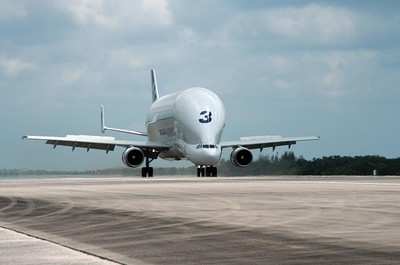Satellite-Based Nav System Offers Precision Approaches
Pau Pyrenees in southern France has become Europe's first
airport to use the new EGNOS Safety-of-Life Service, to guide
aircraft in for landing using only this highly accurate
satellite-based navigation signal.

Clermont-Ferrand Airport in central France is also set to start
using EGNOS - serving mainly business aircraft - while Marseilles
Airport should also join them, chosen because it is used by
Eurocopter for helicopter certification. Le Bourget Airport is also
scheduled to be equipped with EGNOS by the time the Paris Air Show
starts in June.
The European Geostationary Navigation Overlay System (EGNOS)
combines geostationary satellites with a network of ground stations
to sharpen the accuracy of and integrity of GPS signals across
Europe. On 2 March the EGNOS Safety-of-Life Service was officially
made available for the safety-critical task of providing vertical
guidance to aircraft on final approach. This represents the
culmination of 15 years work by ESA, the European Commission, the
EGNOS Operator and Infrastructure Group - a club of seven European
Air Navigation Service Providers - and Eurocontrol, the European
Organisation for the Safety of Air Navigation.
Eurocontrol is now working with the air navigation service
providers in Europe, the airspace users and the national civil
aviation authorities to promote the use of EGNOS. France's
Directorate General for Civil Aviation (DGAC) is among their most
active partners. "Before a suitably equipped aircraft can perform
EGNOS-based approaches to any runway, a dedicated approach
procedure has to be published," explained Benoit Roturier of DGAC.
We aim to publish as many procedures as we can. By 2020, all of
France's approximately 100 airports should be EGNOS-capable."

Routurier said from the point of view of navigation strategy we
see many benefits, notably improving safety on smaller runways,
where no vertically guided approach is available. "For instance,
the availability of EGNOS-based approaches should prevent such
serious accidents as the crash in 1992 involving an Airbus 320 near
Strasbourg," he said. EGNOS gives reliable vertical guidance
everywhere, without any additional local ground-based
infrastructure."
Today France is one of the the European states with the most
runways equipped with instrument landing system (ILS)
infrastructure, but over time the aim would be to rationalise
deployment of this expensive equipment, gradually replacing ILS
with EGNOS-based procedures offering more or less the same level of
performance. France aims to target regional airports and smaller
airlines serving business travellers first - the same development
strategy that has worked well for the Wide Area Augmentation
System, the US equivalent of EGNOS. "Pilots don't need much
retraining, as EGNOS works in much the same way as the current
ILS," added Mr Roturier.
Beluga planes used for transporting Airbus aircraft parts
between industrial sites all over Europe will be the first large
EGNOS-equipped aircraft, with their first certification flights due
to take place later this spring. "Airbus Transport became
interested because their planes go to smaller runways that are not
always ILS-equipped, and they use Pau for training," explained Mr
Roturier. "Eurocontrol, through their 'EGNOS Pioneers' programme,
helped to equip the Belugas and to develop the first procedure, by
sponsoring a consortium led by EGIS-AVIA, a company specialising in
air transport. The main Airbus company also plans to equip its new
A-350 line with EGNOS. The next phase on the avionics side, aiming
at expanding the range of EGNOS-equipped users, would be to look at
retrofitting existing aircraft," he said."
 Airborne-Flight Training 05.09.24: ERAU at AIAA, LIFT Diamond Buy, Epic A&P
Airborne-Flight Training 05.09.24: ERAU at AIAA, LIFT Diamond Buy, Epic A&P ANN's Daily Aero-Term (05.07.24): Hazardous Weather Information
ANN's Daily Aero-Term (05.07.24): Hazardous Weather Information Aero-News: Quote of the Day (05.07.24)
Aero-News: Quote of the Day (05.07.24) NTSB Final Report: Cessna 150
NTSB Final Report: Cessna 150 Aero-News: Quote of the Day (05.08.24)
Aero-News: Quote of the Day (05.08.24)




